Deborah Swift's Blog, page 3
May 13, 2025
Spotlight on The Finding by Jane Hunt #WW2 #CoffeePotBookClub #Wiltshire #Novella
 This poignant novella is a tale of forbidden love, resilience, and the human cost of war.
This poignant novella is a tale of forbidden love, resilience, and the human cost of war.In the quiet fields of Wiltshire during World War II, Eveline, a sheltered young woman, stumbles upon a life-altering discovery: a German Luftwaffe pilot, Fritz, has crash-landed near her home. Against the backdrop of war and suspicion, her family takes the injured man in, nursing him back to health. Beneath his reserved demeanor and burned body, Eveline senses a mystery—and something stirs an unfamiliar longing within her.
As Eveline’s infatuation deepens, she faces a storm of challenges: her overbearing mother’s rigid rules, a zealous preacher’s warnings, and the scrutiny of the town’s gossips. Despite Fritz’s attempts to keep her at arm’s length Eveline’s heart defies reason, falling for the man branded as her enemy.
But Fritz harbors secrets that could shatter Eveline’s fragile world. When the truths of war and the weight of loyalty collide, Eveline must confront the reality of loving someone forbidden.
Will their bond endure the hostility of a nation at war? Or will the scars of betrayal and loss prove impossible to heal?
Buy Link: Universal Buy Link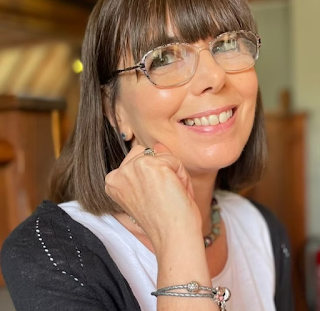 About Jane Born in Reading UK, Jane grew up with a love of reading. She remembers taking Enid Blyton books to bed and reading them under the covers when she should have been asleep! Her love of the written word extended into the classroom where the teachers commented on her vivid imagination and length of stories—probably accompanied with a few sights when they realized the amount of time the reading would take!On leaving school Jane spent a brief spell at college before finding employment as a Dental Nurse where she spent many happy years meeting lots of wonderful people and mixing lots of fillings.After meeting her husband, she later went on to have three children and found work as a Teaching Assistant.Alongside a busy life, she completed a comprehensive writing course, which saw her having non-fiction work published in newspapers and magazines. But the desire to do something ‘creative’ burned ever brightly.Having recently undertaken a lot of research into her family tree, a desire to find out what life was really like for her ancestors took hold, and she developed a fascination with World War 2. Heeding the advice of her late parents to ‘put pen to paper’, she decided to get a story that had been buzzing in her head for quit some time written. The result of her endeavour was a very ‘raw’ manuscript: The Finding.
About Jane Born in Reading UK, Jane grew up with a love of reading. She remembers taking Enid Blyton books to bed and reading them under the covers when she should have been asleep! Her love of the written word extended into the classroom where the teachers commented on her vivid imagination and length of stories—probably accompanied with a few sights when they realized the amount of time the reading would take!On leaving school Jane spent a brief spell at college before finding employment as a Dental Nurse where she spent many happy years meeting lots of wonderful people and mixing lots of fillings.After meeting her husband, she later went on to have three children and found work as a Teaching Assistant.Alongside a busy life, she completed a comprehensive writing course, which saw her having non-fiction work published in newspapers and magazines. But the desire to do something ‘creative’ burned ever brightly.Having recently undertaken a lot of research into her family tree, a desire to find out what life was really like for her ancestors took hold, and she developed a fascination with World War 2. Heeding the advice of her late parents to ‘put pen to paper’, she decided to get a story that had been buzzing in her head for quit some time written. The result of her endeavour was a very ‘raw’ manuscript: The Finding.Get in touch with Jane:
Publisher’s Author Page • Amazon Author Page The post Spotlight on The Finding by Jane Hunt #WW2 #CoffeePotBookClub #Wiltshire #Novella first appeared on Deborah Swift.
The post Spotlight on The Finding by Jane Hunt #WW2 #CoffeePotBookClub #Wiltshire #Novella first appeared on Deborah Swift.
Spotlight on The Finding by Jane Hunt #WW2 #CoffeePotBookClub #Wiltshire
 This poignant novella is a tale of forbidden love, resilience, and the human cost of war.
This poignant novella is a tale of forbidden love, resilience, and the human cost of war.In the quiet fields of Wiltshire during World War II, Eveline, a sheltered young woman, stumbles upon a life-altering discovery: a German Luftwaffe pilot, Fritz, has crash-landed near her home. Against the backdrop of war and suspicion, her family takes the injured man in, nursing him back to health. Beneath his reserved demeanor and burned body, Eveline senses a mystery—and something stirs an unfamiliar longing within her.
As Eveline’s infatuation deepens, she faces a storm of challenges: her overbearing mother’s rigid rules, a zealous preacher’s warnings, and the scrutiny of the town’s gossips. Despite Fritz’s attempts to keep her at arm’s length Eveline’s heart defies reason, falling for the man branded as her enemy.
But Fritz harbors secrets that could shatter Eveline’s fragile world. When the truths of war and the weight of loyalty collide, Eveline must confront the reality of loving someone forbidden.
Will their bond endure the hostility of a nation at war? Or will the scars of betrayal and loss prove impossible to heal?
Buy Link: Universal Buy Link About Jane Born in Reading UK, Jane grew up with a love of reading. She remembers taking Enid Blyton books to bed and reading them under the covers when she should have been asleep! Her love of the written word extended into the classroom where the teachers commented on her vivid imagination and length of stories—probably accompanied with a few sights when they realized the amount of time the reading would take!On leaving school Jane spent a brief spell at college before finding employment as a Dental Nurse where she spent many happy years meeting lots of wonderful people and mixing lots of fillings.After meeting her husband, she later went on to have three children and found work as a Teaching Assistant.Alongside a busy life, she completed a comprehensive writing course, which saw her having non-fiction work published in newspapers and magazines. But the desire to do something ‘creative’ burned ever brightly.Having recently undertaken a lot of research into her family tree, a desire to find out what life was really like for her ancestors took hold, and she developed a fascination with World War 2. Heeding the advice of her late parents to ‘put pen to paper’, she decided to get a story that had been buzzing in her head for quit some time written. The result of her endeavour was a very ‘raw’ manuscript: The Finding.
About Jane Born in Reading UK, Jane grew up with a love of reading. She remembers taking Enid Blyton books to bed and reading them under the covers when she should have been asleep! Her love of the written word extended into the classroom where the teachers commented on her vivid imagination and length of stories—probably accompanied with a few sights when they realized the amount of time the reading would take!On leaving school Jane spent a brief spell at college before finding employment as a Dental Nurse where she spent many happy years meeting lots of wonderful people and mixing lots of fillings.After meeting her husband, she later went on to have three children and found work as a Teaching Assistant.Alongside a busy life, she completed a comprehensive writing course, which saw her having non-fiction work published in newspapers and magazines. But the desire to do something ‘creative’ burned ever brightly.Having recently undertaken a lot of research into her family tree, a desire to find out what life was really like for her ancestors took hold, and she developed a fascination with World War 2. Heeding the advice of her late parents to ‘put pen to paper’, she decided to get a story that had been buzzing in her head for quit some time written. The result of her endeavour was a very ‘raw’ manuscript: The Finding.Get in touch with Jane:
Publisher’s Author Page • Amazon Author Page The post Spotlight on The Finding by Jane Hunt #WW2 #CoffeePotBookClub #Wiltshire first appeared on Deborah Swift.
The post Spotlight on The Finding by Jane Hunt #WW2 #CoffeePotBookClub #Wiltshire first appeared on Deborah Swift.
May 7, 2025
Launch Day for Last Train to Freedom #NewRelease
This was a fascinating book to research and taught me a history that I previously did not know existed. Here is a little background to the book —
The Jewish Community of Kaunas
In Lithuania before the war, Jews made up roughly one-third of Kaunas’s population—about 35,000 people and the city was a major hub of Jewish culture. Institutions like the Slabodka Yeshiva, the Hebrew Gymnasium, and a thriving network of libraries made Kaunas a centerpiece of Jewish life in Eastern Europe. Into this flourishing community came Jewish refugees on the run from Nazi-occupied Europe, and especially from Poland. Already on the run, Jewish intellectuals were soon to face another threat – that of the Soviet invasion.
The Purge of Lithuanian Intellectuals
One of the Soviet regime’s first targets was the Lithuanian intelligentsia—writers, educators, clergy, military officers, and civil servants. Many of them held anti-communist views, were seen as threats to Soviet authority and ideology.
A key example was Vincas Mykolaitis-Putinas, a renowned poet and novelist, whose work symbolized Lithuanian national identity. Though he survived the occupation by keeping a low profile, many of his peers did not.
The most brutal blow came with the mass deportations of June 14, 1941, when the NKVD (Soviet secret police) rounded up over 17,000 Lithuanians and deported them to Siberia, the Arctic, and Kazakhstan. Among them were university professors, doctors, engineers, and clergy, many of whom perished in forced labour camps known as gulags. This systematic removal of Lithuania’s intellectual class aimed to destroy the country’s cultural memory and make way for the Sovietization of society. Of course it included many Jewish intellectuals in its purge, meaning they were caught between a rock and a hard place – the Nazis on the one hand and the Soviets on the other.
Escape from Lithuania
Zofia Kowalski is one of those who must escape and her story is told in Last Train to Freedom. The only way out for Jewish people at that time was via the Japanese Consul Sugihara who arranged visas for them to travel six thousand miles across Russia to reach Vladivostok and from there, a boat to Japan.
Needless to say, her journey is long and difficult, as she is pursued by both the Nazis and the Soviet Secret Police.
Reader reviews on NetGalley so far are excellent.
‘An epic journey across the Siberian wilderness that will keep you guessing until the end. Readers interested in the less well known events of World War II will find this book captivating and unforgettable‘ ⭐⭐⭐⭐⭐
‘Ms Swift is a talented writer… Captivating and compulsive reading’ ⭐⭐⭐⭐⭐
‘What a fantastic read this was’ ⭐⭐⭐⭐⭐
‘Another stunning achievement in historical fiction from Deborah Swift’ ⭐⭐⭐⭐⭐
‘Grips you from the beginning and does not let go until the end‘ ⭐⭐⭐⭐⭐
BUY NOWThe post Launch Day for Last Train to Freedom #NewRelease first appeared on Deborah Swift.May 4, 2025
Bess – Tudor Gentlewoman by Tony Riches #Elizabethan #Tudors #HistoricalFiction
Congratulations to Tony Riches on the launch of BESS – TUDOR GENTLEWOMAN
Book Six of the Elizabethan Series
“A thrilling portrait of a remarkable woman who witnessed the key events of Elizabethan England.”
Bess Throckmorton defies her notorious background and lack of education to become Queen Elizabeth’s Gentlewoman and trusted confidante.
Forced to choose between loyalty and love, duty and desire, will she risk her queen’s anger by marrying adventurer Sir Walter Raleigh without permission?Entangled in a web of intrigue, from the glittering Palace of Whitehall to the cells of the Tower of London, Bess endures tragedy and injustice, becoming a resilient, determined woman, who takes nothing for granted. Can she outwit her enemies, protect her family, and claim her destiny in a world where women are pawns and survival is a game of deadly consequences? This is the true story of the last of the Elizabethans, which ends the story of the Tudor dynasty – and introduces their successors, the Stuarts.
BUY THE BOOK
BUY IN THE UK BUY IN THE US
Kindle, paperback, hardback
About Tony Riches
Tony Riches is a full-time UK author of Tudor historical fiction. He lives with his wife in Pembrokeshire, West Wales and is a specialist in the lives of the early Tudors. As well as his Elizabethan series, Tony’s historical fiction novels include the best-selling Tudor trilogy and his Brandon trilogy, (about Charles Brandon and his wives). For more information about Tony’s books please visit his website tonyriches.com and his blog, The Writing Desk and find him on Facebook, Instagram, Bluesky and Twitter @tonyriches.
The post Bess – Tudor Gentlewoman by Tony Riches #Elizabethan #Tudors #HistoricalFiction first appeared on Deborah Swift.April 24, 2025
The Florence Sisters by Tessa Harris #WW2 #Review #HistoricalFiction
 The Florence Sisters
The Florence Sisters
A war-torn city. A stolen masterpiece. Two lives in the balance…
Italy, 1940. With Florence on the cusp of war, Il Scorpione, the no-nonsense Englishwomen of the city, find their genteel livelihoods under grave threat by the approach of the Nazis. Tea rooms and bookshops are closed by the Fascists, and the women are forced to join the war effort.
Desperate to help in any way that she can, Angelina Leone, expert art-historian and the half-Italian niece of Il Scorpione’s founder makes a deal with the devil. To guarantee her beloved Aunt Agatha, the only family she has, safe passage across the city, Lina must authenticate the art ruthlessly stolen from Jewish families. But when she comes across a priceless portrait – one that she cannot bear to see seized by the Germans – Lina declares the masterpiece a fake. But in doing so, will she set off a chain of events with consequences more deadly than she could ever imagine …
REVIEWAn exploration of the art world in Florence during WW2 in which the Nazis are trying to loot the treasures of Florence for their private collections. This story shows the effort that went in to protecting and saving the masterpieces of Italian art in the Uffizi gallery and elsewhere, and the risks some women took to preserve them. Lina is an engaging heroine, but I had a soft spot for her formidable aunt and the other ladies of The English Lades Art Appreciation Society who gave up their time and loyalty under considerable duress. It is unusual to read about older women and the eye-opening risks they took in their contribution to the war effort.
There is a nice tension between Lina and the owner of a gallery, Edoardo, who may or may not be a Nazi collaborator. Lina has to navigate this uncertainty whilst slowly falling for this enigmatic dealer, whose reputation means that he cannot be trusted.
Based on real events, this is a suspenseful novel of bravery and determination in the face of Nazi greed. Tessa Harris gives us a world of heightened passions – the beauty of art, a constant sense of danger, and a desperate romance that simmers beneath it all. Highly recommended.
BUY THE BOOKThe post The Florence Sisters by Tessa Harris #WW2 #Review #HistoricalFiction first appeared on Deborah Swift.April 21, 2025
The Ballad of Mary Kearney by Katherine Mezzacappa
ABOUT THE BOOK
‘I am dead, my Mary; the man who loved you body and soul lies in some dishonorable grave.’
In County Down, Ireland, in 1767, a nobleman secretly marries his servant, in defiance of law, class, and religion. Can their love survive tumultuous times?
‘Honest and intriguing, this gripping saga will transport and inspire you, and it just might break your heart. Highly recommended.’ Historical Novel Society
‘Mezzacappa brings nuance and a great depth of historical knowledge to the cross-class romance between a servant and a nobleman.’ Publishers Weekly.
The Ballad of Mary Kearney is a compelling must-read for anyone interested in Irish history, told through the means of an enduring but ultimately tragic love.
Here is Katherine to talk about the book:
‘But one object was I able to save from the wreckage of their bedroom—a likeness of Lord Goward when Viscount done by a pastellist in Venice after the manner of Rosalba—wearing a domino and a look of mischief.’
The hero of my story, James Goward, in common with many Ascendancy gentlemen and contemporaries of their class in Britain, made his Grand Tour of the continent, from which he returns just before the novel opens. In Rome, he follows the practice of many Grand Tourists, and was painted full-length by Pompeo Batoni (or as James’s mother refers to him in correspondence, ‘Mr Battoney’: ‘the painting looks very fine with him gesturing at all those ruins as if he had discovered them himself.’) with the finished canvas being delivered to Ireland months later. In Venice, he sits for his portrait in pastels. Rosalba Carriera (1673-1757) was dead by the time James made his tour, so I had him depicted by one of her imitators, in the style of her 1730 portrait of the young Irish nobleman, Lord Boyne.

Image Rosalba Carriera:
Self portrait of Rosalba Carriera, c. 1743-1747
Accademia Gallery, Venice
Rosalba Carriera was the daughter of a Venetian lawyer and was initially trained in that most Venetian of feminine roles, lace making, but for economic reasons she turned first to painting miniatures on the lids of snuff boxes before proceeding to portraits in pastels. Her two sisters worked as her assistants. She was sought out by the Grand Tourists. As her sitters included Maximilian II of Bavaria, Frederick IV of Denmark and Augustus the Strong, King of Poland and Elector of Saxony, her fame spread beyond her native city. She worked in Paris in the early 1720s (where she painted Louis XV) and in 1730 was at the court of the emperor Charles VI in Vienna, as well as travelling through northern and central Italy. Rosalba, as she was generally known, outlived all her family, but in her later years was afflicted by the worst disability a painter could have: she underwent failed operations for cataract and went blind.
Rosalba, in common with other women artists who are only now taking their rightful place in the pantheon, has sometimes been sidelined by art historians (though the variable popularity of the Rococo style has had something to do with this). John Steer, author of a standard text, A Concise History of Venetian Painting, granted her a paragraph and one illustration. He acknowledged that she was ‘internationally the most important of Venetian eighteenth-century portraitists’ and that she impacted the development of French artists of the period, like Boucher and Greuze, but described her portraits as having ‘a sweet, surface elegance, but little concern with depth of character’ and noted her ‘idealized figures of pretty women in a variety of allegorical roles.’ Her self-portrait in the Accademia in Venice suggests anything but ‘surface elegance’, and she certain appears to have considerable depth of character.
What’s next for Katherine?
I intend to return to Venice, about which I have written before, in a novel I am planning on the life of the feminist writer Lucrezia Marinella (1571-1653) and her milieu of the literary and philosophical academies which flourished in the city in her time.
Works by Rosalba Carriera:

Image Viscount Boyne:
Gustavus Hamilton, 2nd Viscount Boyne
Rosalba Carriera, 1730
Metropolitan Museum of Art, New York
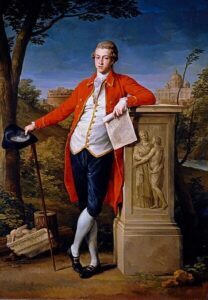 Image Baronet Dunstanville :
Image Baronet Dunstanville :
Francis Basset, 1st Baronet de Dunstanville
Pompeo Batoni, 1778
The sitter is shown against a backdrop of the Castel Sant’Angelo and St Peter’s, but Basset never received the finished portrait. The ship on which it was travelling was seized by the French and the painting was sold to the Spanish. It is now in the Prado, Madrid.
Source: Wikimedia Commons
Buy The Ballad of Mary Kearney
About Katherine Mezzacappa
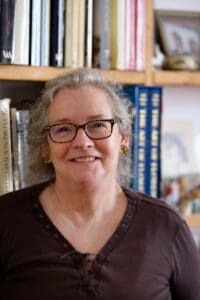 Katherine Mezzacappa is Irish but currently lives in Carrara, between the Apuan Alps and the Tyrrhenian Sea. She wrote The Ballad of Mary Kearney (Histria) and The Maiden of Florence (Fairlight) under her own name, as well as four historical novels (2020-2023) with Zaffre, writing as Katie Hutton. She also has three contemporary novels with Romaunce Books, under the pen name Kate Zarrelli.
Katherine Mezzacappa is Irish but currently lives in Carrara, between the Apuan Alps and the Tyrrhenian Sea. She wrote The Ballad of Mary Kearney (Histria) and The Maiden of Florence (Fairlight) under her own name, as well as four historical novels (2020-2023) with Zaffre, writing as Katie Hutton. She also has three contemporary novels with Romaunce Books, under the pen name Kate Zarrelli.
Katherine’s short fiction has been published in journals worldwide. She has in addition published academically in the field of 19th century ephemeral illustrated fiction, and in management theory. She has been awarded competitive residencies by the Irish Writers Centre, the Danish Centre for Writers and Translators and (to come) the Latvian Writers House.
Katherine also works as a manuscript assessor and as a reader and judge for an international short story competition. She has in the past been a management consultant, translator, museum curator, library assistant, lecturer in History of Art, sewing machinist and geriatric care assistant. In her spare time she volunteers with a second-hand book charity of which she is a founder member. She is a member of the Society of Authors, the Historical Novel Society, the Irish Writers Centre, the Irish Writers Union, Irish PEN / PEN na hÉireann and the Romantic Novelists Association, and reviews for the Historical Novel Review. She has a first degree in History of Art from UEA, an M.Litt. in Eng. Lit. from Durham and a Masters in Creative Writing from Canterbury Christ Church. She is represented by Annette Green Authors’ Agency.
Author Links:
Website: https://katherinemezzacappa.com/
Facebook: https://www.facebook.com/katherinemezzacappafiction
LinkedIn: https://www.linkedin.com/in/katherine-mezzacappa-09407815/
Instagram: https://www.instagram.com/katmezzacappa/
Bluesky: https://bsky.app/profile/katmezzacappa.bsky.social
Amazon Author Page: https://www.amazon.com/author/katherinemezzacappa
Thank you to Katherine and The Coffee Pot Book Club for this interesting post.
The post The Ballad of Mary Kearney by Katherine Mezzacappa first appeared on Deborah Swift.March 19, 2025
Spotlight on Strait Lace by Rosemary Hayward #Edwardian #CoffeePotBookClub
It is 1905. Edwardian England. Harriet Loxley, the daughter of a vicar and niece to a prominent Nottingham lace manufacturer, spends her days playing cricket with her brother, scouring the countryside for botanical specimens, and never missing an opportunity to argue the case for political power for women. Given the chance to visit the House of Commons, Harriet witnesses the failure of a historic bill for women’s voting rights. She also meets the formidable Pankhurst women.
When Harriet gets the chance to study biology at Bedford College, London, she finds her opportunity to be at the heart of the fight. From marching in the street, to speaking to hostile crowds, to hurling stones through windows, just how far will Harriet go?
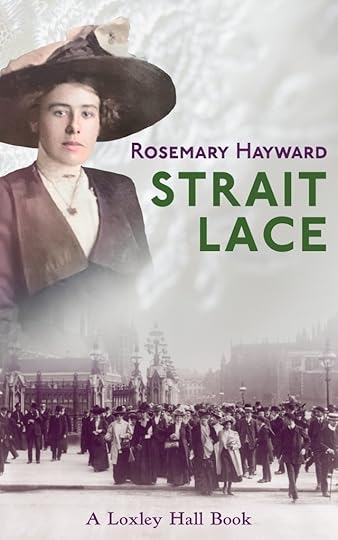
Rosemary Hayward is the author of Margaret Leaving, a historical mystery uncovering little known events that occurred in the immediate aftermath to World War II. She is also the creator of Your Next Book, a deeply nerdy monthly newsletter describing a book picked from her bookshelf, or Kindle.
She is British by birth but now lives part of the year in California and part in southern Spain.
Author Links:
Website: www.rosemaryhayward.com
Facebook: https://www.facebook.com/Rosemary-Hayward-1460369174026124
LinkedIn: https//www.linkedin.com/in/rosemary-hayward-6544ba60
Instagram: https://www.instagram.com/margaretleaving/
Threads: https://www.threads.net/@margaretleaving
Pinterest: https://www.pinterest.com/hayward0738/_saved/
Book Bub: https://www.bookbub.com/profile/rosemary-hayward
Amazon Author Page: https://www.amazon.com/stores/Rosemary-Hayward/author/B06XR7GZR4
Goodreads: https://www.goodreads.com/author/show/16658743.Rosemary_Hayward
The post Spotlight on Strait Lace by Rosemary Hayward #Edwardian #CoffeePotBookClub first appeared on Deborah Swift.March 6, 2025
Death of a Princess by R N Morris #Review #CoffeePotBookClub #CrimeFiction
Summer 1880.
Lipetsk, a spa town in Russia.
The elderly and cantankerous Princess Belskaya suffers a violent reaction while taking a mud bath at the famous Lipetsk Sanatorium. Soon after, she dies. Dr Roldugin, the medical director of the sanatorium, is at a loss to explain the sudden and shocking death. He points the finger at Anna Zhdanova, a medical assistant who was supervising the princess’s treatment. Suspicion also falls on the princess’s nephew Belsky, who appears far from grief-stricken at his aunt’s death. Meanwhile, investigating magistrate Pavel Pavlovich Virginsky arrives in Lipetsk from St Petersburg, seeking treatment after a nervous breakdown.
Review
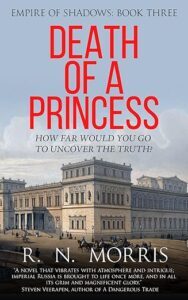 I love stories with damaged and interesting characters and Virginsky, the protagonist in this book is suffering from distress so severe that all he wants to do is to attend a sanatorium and rest. As it progresses we find out who he is and that something ‘in the past’ has unsettled him to the degree he needs help. But this being a murder mystery, of course as soon as he arrives at the sanatorium, a person is murdered. In this case it is the elderly Princess Belskaya who has supposedly suffered an allergic reaction to the mud bath that was meant to cure her eczema. Mila, one of the nurses, is suspicious and suspects foul play but it is not long before she is kidnapped by a cohort of revolutionaries who are residing nearby. More murders ensue, and Virginsky must unravel them all.
I love stories with damaged and interesting characters and Virginsky, the protagonist in this book is suffering from distress so severe that all he wants to do is to attend a sanatorium and rest. As it progresses we find out who he is and that something ‘in the past’ has unsettled him to the degree he needs help. But this being a murder mystery, of course as soon as he arrives at the sanatorium, a person is murdered. In this case it is the elderly Princess Belskaya who has supposedly suffered an allergic reaction to the mud bath that was meant to cure her eczema. Mila, one of the nurses, is suspicious and suspects foul play but it is not long before she is kidnapped by a cohort of revolutionaries who are residing nearby. More murders ensue, and Virginsky must unravel them all.
This is a gripping mystery with interesting and well-developed characters. The atmospheric location of Lipetsk with its rivers and gloomy factories sets the scene nicely for the revolutionaries intent on sabotaging the ironworks. The volatile relationship between these young rebels, all under false identities, and intent on a terrorist plot,explores the falsity behind Zotov’s idea that there ‘can be no crime under a criminal regime’.
The murders are gruesome and believable and there is the added bonus of drama, intrigue and a few explosions before we hit the surprising denouement. Pitted against all this is a man who is barely sane and residing in a facility for treating people with nervous disorders. The question of whether or not he should believe the evidence of his own eyes not only stymies his investigations with the magistrates and the local police, but also leads him to question his own deductions.
This is a great read with characters that feel real, and one that immerses the reader in a fascinating and unusual time and place. Want to escape the humdrum? Then this is highly recommended.
BUY THE BOOKAbout the Author

Roger (R.N) Morris is the author of 18 books, including a quartet of historical crime novels set in St Petersburg featuring Porfiry Petrovich, the investigating magistrate from Dostoevsky’s great novel Crime and Punishment. These were followed by the Silas Quinn series set in London in 1914. He has been shortlisted for the CWA Duncan Lawrie Gold Dagger and the CWA Historical Dagger.
A former advertising copywriter, Roger has written the libretto for an opera, modern retellings of Frankenstein and Macbeth for French school children. He’s also a scriptwriter for an award winning audio producer, working on true crime and history podcasts including The Curious History of your Home.
His work has been published in 16 countries.
Married with two grown-up children, Roger lives in Chichester where he keeps an eye out for seagulls.
Connect with R N Morris
Website: www.rogernmorris.co.uk
Twitter: https://x.com/rnmorris
Facebook: www.facebook.com/roger.morris.7547
LinkedIn: www.linkedin.com/in/roger-morris-41679518
Instagram: www.instagram.com/rogermorris7988
Threads: www.threads.net/@rogermorris7988
Bluesky: https://bsky.app/profile/rnmorris.bsky.social
Pinterest: www.pinterest.com/rogernmorris1
Amazon Author Page: www.amazon.co.uk/stores/author/B001JP9XXA
Goodreads: www.goodreads.com/author/show/608784.R_N_Morris
The post Death of a Princess by R N Morris #Review #CoffeePotBookClub #CrimeFiction first appeared on Deborah Swift.February 27, 2025
Ghost Encounters by Helen and Kathy Hollick #CoffeePotBookClub
 Everyone assumes that ghosts are hostile.
Everyone assumes that ghosts are hostile.Actually, most of them are not.You either believe in ghosts or you don’t. It depends on whether you’ve encountered something supernatural or not. But when you share a home with several companionable spirits, or discover benign ghosts in public places who appear as real as any living person, scepticism is abandoned and the myth that ghosts are to be feared is realised as nonsense.It is a matter for individual consideration whether you believe in ghosts or not, but for those who have the gift to see, hear or be aware of people from the past, meeting with them in today’s environment can generate a connection to years gone by.Kathy and Helen Hollick have come across several such departed souls in and around North Devon and at their 18th-century home, which they share with several ‘past residents’.In Ghost Encounters: The Lingering Spirits Of North Devon, mother and daughter share their personal experiences, dispelling the belief that spirits are to be feared.Ghost Encounters will fascinate all who enjoy this beautiful region of rural South-West England, as well as interest those who wish to discover more about its history… and a few of its ghosts.(Includes a bonus of two short stories and photographs connected to North Devon.)BUY THE BOOKGhost Encounters is available to read on #KindleUnlimited.
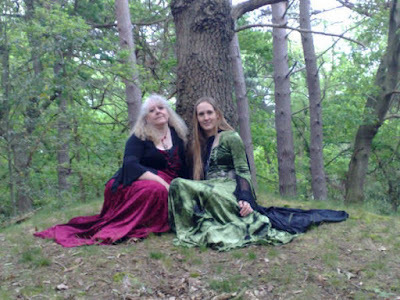 Helen HollickKnown for her captivating storytelling and rich attention to historical detail, Helen might not see ghosts herself, but her nautical adventure series, and some of her short stories, skilfully blend the past with the supernatural, inviting readers to step into worlds where the boundaries between the living and the dead blur. Helen, husband Ron and daughter Kathy moved from London to Devon in January 2013 after a Lottery win on the opening night of the London Olympics, 2012. She spends her time glowering at the overgrown garden and orchard, fending off the geese, helping with the horses and, when she gets a moment, writing the next book…Kathy HollickDiagnosed as severely dyslexic when she was ten, Helen pulled Kathy out of school at fifteen to concentrate on everything equine. When not encountering friendly ghosts, Kathy’s passion is horses and mental well-being. She started riding at the age of three, had her own Welsh pony at thirteen, and discovered showjumping soon after. Kathy now runs her own Taw River Equine Events, and coaches riders of any age or experience, specialising in positive mindset and overcoming confidence issues via her Centre10 accreditation and Emotional Freedom Technique training. EFT, or ‘tapping’, uses the body’s pressure points to aid calm relaxation and to promote gentle healing around emotional, mental or physical issues. Kathy lives with her farmer partner, Andrew, in their flat adjoining the main farmhouse. She regularly competes at affiliated British Showjumping, and rides side-saddle (‘aside’) when she has the opportunity. She produces her own horses, several from home-bred foals. She also has a fun diploma in Dragons and Dragon Energy, which was something amusing to study during the Covid lockdown.
Helen HollickKnown for her captivating storytelling and rich attention to historical detail, Helen might not see ghosts herself, but her nautical adventure series, and some of her short stories, skilfully blend the past with the supernatural, inviting readers to step into worlds where the boundaries between the living and the dead blur. Helen, husband Ron and daughter Kathy moved from London to Devon in January 2013 after a Lottery win on the opening night of the London Olympics, 2012. She spends her time glowering at the overgrown garden and orchard, fending off the geese, helping with the horses and, when she gets a moment, writing the next book…Kathy HollickDiagnosed as severely dyslexic when she was ten, Helen pulled Kathy out of school at fifteen to concentrate on everything equine. When not encountering friendly ghosts, Kathy’s passion is horses and mental well-being. She started riding at the age of three, had her own Welsh pony at thirteen, and discovered showjumping soon after. Kathy now runs her own Taw River Equine Events, and coaches riders of any age or experience, specialising in positive mindset and overcoming confidence issues via her Centre10 accreditation and Emotional Freedom Technique training. EFT, or ‘tapping’, uses the body’s pressure points to aid calm relaxation and to promote gentle healing around emotional, mental or physical issues. Kathy lives with her farmer partner, Andrew, in their flat adjoining the main farmhouse. She regularly competes at affiliated British Showjumping, and rides side-saddle (‘aside’) when she has the opportunity. She produces her own horses, several from home-bred foals. She also has a fun diploma in Dragons and Dragon Energy, which was something amusing to study during the Covid lockdown.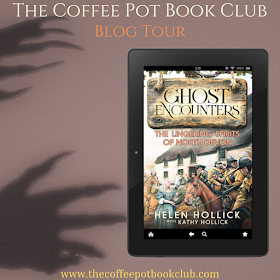 Connect with Helen: Website • Blog • Twitter / X • Facebook • BlueskyAmazon Author Page • Newsletter
Connect with Helen: Website • Blog • Twitter / X • Facebook • BlueskyAmazon Author Page • NewsletterConnect with Kathy: Website • Facebook
The post Ghost Encounters by Helen and Kathy Hollick #CoffeePotBookClub first appeared on Deborah Swift.
February 17, 2025
The Fires of Gallipoli by Barney Campbell Excerpt #CoffeePotBookClub #WW1
The Fires of Gallipoli by Barney Campbell
Autumn turned into winter. The battalion moved a mile to the north-west of the blind crests to relieve a unit that was deemed combat ineffective following the twin heads of a failed attack and a virulent strain of dysentery that had torn through it.
Progress up to the line was appallingly slow, rivulets of loose earth and rocks running down the trench walls to line the bottoms with obstacles. To Edward, sleep-deprived and hallucinating in the cold, it was as though he was a giant treading through a twilit valley, the countless little landslips becoming mighty waterfalls tumbling down the sides into the plain below. His feet – as they stumbled on the pebbles and stones – were great hammers that crushed houses and villages. He realised he was grinning and that the sounds that punctuated his progress were his own short bursts of laughter. He took several gulps of air to snap out of it and hoped that no one had noticed him in that state.
The next day, the men got used to the tiny strip of ground that was now their home, titivating the line and getting to grips with the lie of their land.
And then came the evening. The normal weather of the daytime, no different from the hundred that had preceded it save for winter’s siphoning away its daily ration of heat, passed into a squally, adolescent late afternoon with fast-moving clouds scudding across the sky before a vast grey blanket was pulled across it.
At seven o’clock the first drops spattered down onto them, tiny pinpricks to start but growing soon to fat droplets that sounded like sleet as they hit helmets and hands clenched round rifles. They kicked up sand round the rims of the tiny craters they bored in the ground, soldiers craning their necks back to let them fall onto parched tongues. Within ten minutes, the rain had whipped up to a tempo that would not drop for three days, skin, uniform and ground all now equally saturated and the men sitting there like cattle, morale and discipline melting away.
After half an hour, Edward had never seen the men so low, so visibly deflated, so defeated. The wind picked up and up, each gust bringing waves of freezing rain onto their scant, thin uniforms. They started to shiver uncontrollably, some lucky ones seeking shelter under the flimsiest tarpaulins. Those who couldn’t sat in the bottom of trenches that had quickly become swamps, hands thrust into pockets, their necks bent forward over their chests as rifles were cast into the mud, sentry duties abandoned, anything military forgotten about. Each minute rammed home that the biggest threat to their survival now came not from the Turks but from the weather.
The darkness was total, with the moon entirely obscured. The mud grew into an ooze that sucked in anything that fell on it, a slick, slippy filth that afforded no purchase for their boots, the leather already sodden and chafing. Edward held off from looking at his watch for as long as he could, but eventually broke and saw its luminous hands tell him it was only nine o’clock; it felt like four in the morning. He was so cold that he knew that to sit and sleep might be fatal; he had to keep moving, so he began a lonely plod up and down the trench, slipping and sliding, cutting himself a dozen times, anything to keep moving, anything to encourage the men.
 The Fires of Gallipoli is a heartbreaking portrayal of friendship forged in the trenches of the First World War.‘In this vivid and engaging novel of war and friendship, Barney Campbell shows us once again that he is a natural writer. This is a novel of men at arms of the highest quality.’
The Fires of Gallipoli is a heartbreaking portrayal of friendship forged in the trenches of the First World War.‘In this vivid and engaging novel of war and friendship, Barney Campbell shows us once again that he is a natural writer. This is a novel of men at arms of the highest quality.’~ Alexander McCall SmithEdward Salter is a shy, reserved lawyer whose life is transformed by the outbreak of war in 1914. On his way to fight in the Gallipoli campaign, he befriends the charming and quietly courageous Theodore Thorne. Together they face the carnage and slaughter, stripped bare to their souls by the hellscape and only sustained by each other and the moments of quiet they catch together.Thorne becomes the crutch whom Edward relies on throughout the war. When their precious leave from the frontline coincides, Theo invites Edward to his late parents’ idyllic estate in Northamptonshire. Here Edward meets Thorne’s sister Miranda and becomes entranced by her.Edward escapes the broiling, fetid charnel-house of Gallipoli to work on the staff of Lord Kitchener, then on to the Western Front and post-war espionage in Constantinople. An odd coolness has descended between Edward and Theo. Can their connection and friendship survive the overwhelming sense of loss at the end of the war when everything around them is corrupted and destroyed?The Fires of Gallipoli is a heartbreaking, sweeping portrayal of friendship and its fragility at the very limits of humanity.
 Barney Campbell, author of The Fires of Gallipoli, was brought up in the Scottish Borders and studied Classics at university. He then joined the British Army where he commanded soldiers on a tour of Helmand Province, Afghanistan at the height of the war there.That experience inspired him to write his first novel, Rain, a novel about the war, which was published by Michael Joseph in 2015. The Times called it ‘the greatest book about the experience of soldiering since Robert Graves’s First World War classic Goodbye To All That’.Barney has walked the length of the Iron Curtain, from Szczecin in Poland to Trieste in Italy. He currently works and lives in London.Author Links:Amazon Author Page • Goodreads • Publisher’s Author PagePublisher Links:Website • Twitter / X • LinkedIn • Instagram • BlueskyThe post The Fires of Gallipoli by Barney Campbell Excerpt #CoffeePotBookClub #WW1 first appeared on Deborah Swift.
Barney Campbell, author of The Fires of Gallipoli, was brought up in the Scottish Borders and studied Classics at university. He then joined the British Army where he commanded soldiers on a tour of Helmand Province, Afghanistan at the height of the war there.That experience inspired him to write his first novel, Rain, a novel about the war, which was published by Michael Joseph in 2015. The Times called it ‘the greatest book about the experience of soldiering since Robert Graves’s First World War classic Goodbye To All That’.Barney has walked the length of the Iron Curtain, from Szczecin in Poland to Trieste in Italy. He currently works and lives in London.Author Links:Amazon Author Page • Goodreads • Publisher’s Author PagePublisher Links:Website • Twitter / X • LinkedIn • Instagram • BlueskyThe post The Fires of Gallipoli by Barney Campbell Excerpt #CoffeePotBookClub #WW1 first appeared on Deborah Swift.



